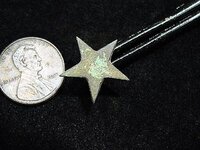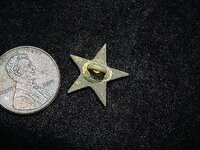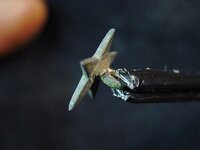Woodland Detectors
Gold Member
Composition of "Star" Attachement Review complete
The verdict could be this star was a Reunion button. I was hoping we could get a solid Id so we may understand these further. I'm sorry, It's all I can do. I have emailed many people pertaining this attachement with most never seeing one before...It's functionality, however, May be never known.....Cheers, mike The following are Dr. Miller comments of University Of North Carolina:
Mr. Post, Attached are six chemical analyses of the star you submitted to me for analysis. The first three (Sp 1-Sp 3) were taken from the back side of the star, to try to access the least weathered part of the star. As you can see, the star is composed mostly of copper, with other impurities. I expect that the tin (Sn), silver (Ag), molybdenum (Mo), and perhaps iron (Fe), were part of the original copper ore and that the rest of the elements detected are impurities from the sediment you found the star in. The other three analyses were taken from the soldered surface that affixes the loop to the star. Similarly, I expect the tin (Sn) was part of the solder, and I expect that analysis Sp 6. with its higher tin, lead, and zinc amounts, is closer to the original composition of the solder. The other two analyses (Sp 4 and Sp 5) may have been taken over areas where the solder had corroded away or was thinner than the point where Sp 6 was taken. Because I am in and out of the office during the summer, I will leave your star with our secretary, Debra Robbins, who is located in our main office, Robinson Hall 224. I hope that helps. J.W. Miller Star artifact (weight percent)
Back side of star/metal surface Back side of star, solder surface
Sp 1 Sp2 Sp3 Sp4 Sp5 Sp6
Si 2.04 0.49 0.62 0.65 0.69 6.71
P 2.38 0.71 1.27
S 4.43 0.88
K 0.30
Ca 0.16 0.50 0.27 0.12 0.57
Ti 0.13
Fe 0.59 0.31 0.69 0.45 0.71 1.04
Cu 91.49 94.73 96.45 97.71 94.82 61.31
Zn 0.00 1.96 3.73
Zr 0.29
As 0.00
Mo 0.83
Ag 0.87
Sn 0.73 0.44 0.45 1.05 22.34
Pb 3.02
Au 0.75 0.35
total 100.01 100.02 100.01 100.01 99.99 99.99
The verdict could be this star was a Reunion button. I was hoping we could get a solid Id so we may understand these further. I'm sorry, It's all I can do. I have emailed many people pertaining this attachement with most never seeing one before...It's functionality, however, May be never known.....Cheers, mike The following are Dr. Miller comments of University Of North Carolina:
Mr. Post, Attached are six chemical analyses of the star you submitted to me for analysis. The first three (Sp 1-Sp 3) were taken from the back side of the star, to try to access the least weathered part of the star. As you can see, the star is composed mostly of copper, with other impurities. I expect that the tin (Sn), silver (Ag), molybdenum (Mo), and perhaps iron (Fe), were part of the original copper ore and that the rest of the elements detected are impurities from the sediment you found the star in. The other three analyses were taken from the soldered surface that affixes the loop to the star. Similarly, I expect the tin (Sn) was part of the solder, and I expect that analysis Sp 6. with its higher tin, lead, and zinc amounts, is closer to the original composition of the solder. The other two analyses (Sp 4 and Sp 5) may have been taken over areas where the solder had corroded away or was thinner than the point where Sp 6 was taken. Because I am in and out of the office during the summer, I will leave your star with our secretary, Debra Robbins, who is located in our main office, Robinson Hall 224. I hope that helps. J.W. Miller Star artifact (weight percent)
Back side of star/metal surface Back side of star, solder surface
Sp 1 Sp2 Sp3 Sp4 Sp5 Sp6
Si 2.04 0.49 0.62 0.65 0.69 6.71
P 2.38 0.71 1.27
S 4.43 0.88
K 0.30
Ca 0.16 0.50 0.27 0.12 0.57
Ti 0.13
Fe 0.59 0.31 0.69 0.45 0.71 1.04
Cu 91.49 94.73 96.45 97.71 94.82 61.31
Zn 0.00 1.96 3.73
Zr 0.29
As 0.00
Mo 0.83
Ag 0.87
Sn 0.73 0.44 0.45 1.05 22.34
Pb 3.02
Au 0.75 0.35
total 100.01 100.02 100.01 100.01 99.99 99.99






